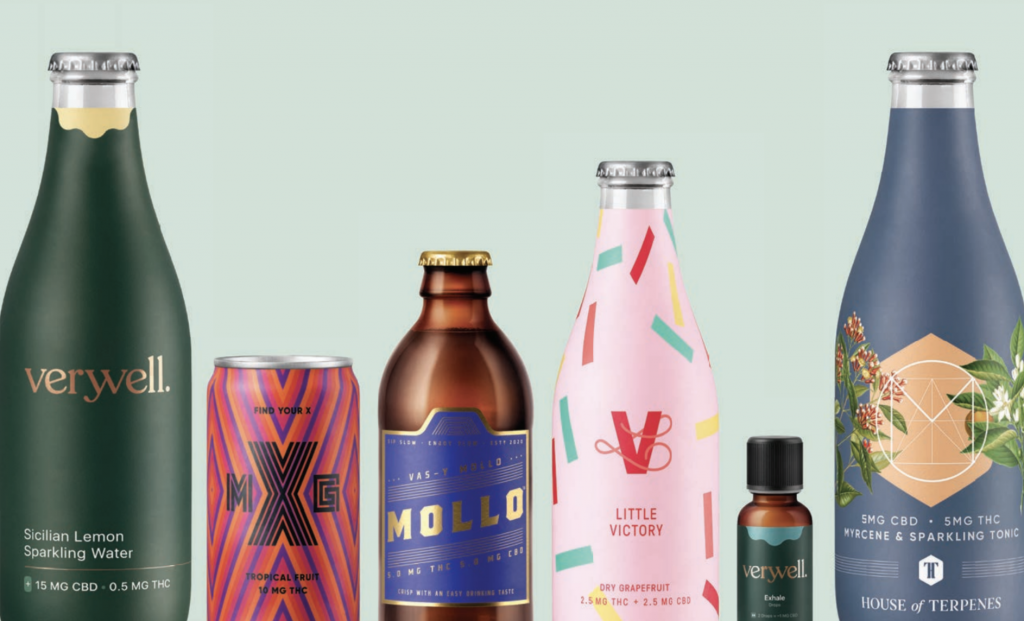Food & Drink
Cannabis-Infused Beverages Are Now Available in Canada
Here's what you need to now about the next generation of consumable cannabis products.
by : Melissa Fejtek- Sep 23rd, 2020

October marks the one year anniversary of the approval of cannabis edibles and extracts in Canadian markets. Since then, this category of palatable CBD-and-THC-infused products has expanded to include an entirely new way of consuming cannabis: drinkable weed. Over the past year and a half, Molson Coors and cannabis producer Hexo have consulted everyone from heavy cannabis consumers to people who avoid marijuana altogether to develop five cannabis beverage brands under the umbrella company Truss Beverage Co that will offer controlled doses of CBD and THC in a variety of flavours and potency levels.
“The nice thing about beverages is they’re very familiar,” says Melanie Smith, innovation lead for the brand. “Think about it: you get up and you have your coffee, you drink some water, you might have a soda at lunch. Beverages fit really seamlessly into people’s lives because we understand how and when to consume them.” Beverages are discreet and offer a unique alternative to smoking marijuana (according to a study by the brand, 71 percent of Canadians of legal age cite not wanting to smoke as the primary barrier to consuming cannabis). Best of all, these sparkling bevvys act without the waiting time – and often intensity – of edibles. We spoke with Smith to learn more about this buzzy new category of beverages and how they work.
How are cannabis-infused beverages formulated?
Cannabis isn’t naturally water soluble. It’s like making a salad dressing: you have to break it down into very tiny particles to get it to mix with the water. By breaking down those particles into tiny bits, it allows a faster onset and offers a really controlled experience.
What are the effects like?
It’s a really personal experience. It’s difficult to describe the actual effects that you might feel. It really depends on your endocannabinoid system, your experience with cannabis and what you ate that day. But the nice thing about cannabis beverages is they offer a very consistent experience. Fifteen to 30 minutes is about the average onset time and then you usually stop feeling the effects around the 1.5 to 2-hour mark.
What’s the difference between taking a glass of water or juice and adding CBD or THC oil versus having an infused beverage?
If you were to add an oil, typically it would float on the top of your beverage. It doesn’t naturally want to mix – kind of like the salad dressing analogy. Oils naturally take longer to absorb in the body, similar to edibles. Some people have had a brownie or a cookie in the past and not felt the effects for an hour or beyond. With [infused] beverages you’ll feel the effects much faster, which is really important especially when you think about safety. If the effects didn’t come into play for an hour and a half, it would be very easy to over consume. So for us, it’s really about delivering that consistent experience. You have a beverage, wait 30 minutes, see how you’re feeling and then it’s up to you to see if you want to reach for a second one.
How much would someone with a high tolerance, like daily cannabis consumers, have to consume to get high?
Anecdotally, we’ve seen people commenting online about the maximum dose being 10 milligrams, and they think, oh, wow, that’s so light. But because of the way that your body absorbs it, you would feel [the effects] much faster in a beverage versus in edibles. We’re actually seeing people who identify as heavy users being quite surprised at the kind of impact they get from a beverage. Always start low and work up. Don’t assume that you can jump right in at the 10 milligram maximum, because it is such a different format from what else is out there.
Truss is launching with five different brands and a total of 16 products. How does one choose the best option for them?
It really comes back to the occasion. A self-care, chilling-at-home moment is very different from something that you want to drink at a party. We felt like we developed the right portfolio of brands that connected with each of those occasions. In such a regulated environment, there’s only so much you can say on packaging. When you develop a brand specific to each occasion, it really allows you to help people understand what the products are for and how and when they’re meant to be consumed.

The Mollo products kind of resemble beer bottles. Is that what Truss was trying to go for with that look?
Alcohol and cannabis never mix. We know that there are a lot of social occasions where people may be looking for an alternative to alcohol. For us, it was about finding the appropriate liquid types. We did want to create something that was appropriate for one of those beer occasions, so using [that style of] bottle and having a liquid that is crisp and refreshing and has got a bit of hops in it, it really [fits with a] backyard barbecue with friends.
How did you determine what potency works best for each product? Did you vary the potency depending on the branding?
Everything comes back to those occasions and thinking about what makes sense both for the liquid type and a potency perspective. XMG, our highest potency [beverage], is a good example. That was designed for the current heavy user that wants a higher hit – we call it a mood shift. It’s meant for somebody that’s either coming home from work and needs to melt into the couch and watch some TV, or for somebody that wants to shift gears and is going to a party. With Veryvell, which is our self-care brand, it’s more about CBD-only drinks and relaxing at home on a Sunday or after a long day. With a brand like House of Terpenes, it’s like a mocktail-esque type drink. We were really inspired by the world of terpenes and allowing people to explore elements of the plant, almost like the world of hops and craft beer. A five milligram [potency] made sense there because it’s not meant to be something as sessionable where you may have three or four drinks, it’s more akin to a cocktail, where you might have one or two and savour it.
READ MORE:
The Best Canadian-Made Rosé Wines
Newsletter
Join our mailing list for the latest and biggest in fashion trends, beauty, culture and celebrity.
More from Food & Drink
Read Next

Fashion
Are Fashion Brands Getting Greener?
While the fashion industry is making a lot of noise about being more sustainable, a closer look shows that its earth-friendly commitments are often more illusion than reality.
by : Marouchka Franjulien- Apr 19th, 2024

Beauty
What Beauty Packaging Is Actually Sustainable?
We sought out leaders in the field to help us get to the bottom of the blue bin once and for all.
by : Victoria Christie- Apr 19th, 2024

Beauty
Tested and Approved: A Skin Saviour That Works While You Sleep
Wake up with your glowiest skin yet—even if you didn’t clock eight hours.
by : ELLE Canada- Apr 11th, 2024




